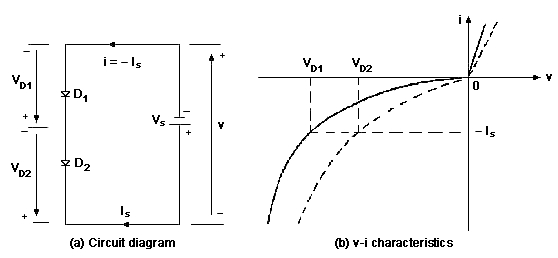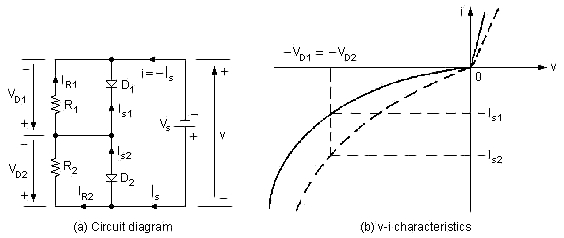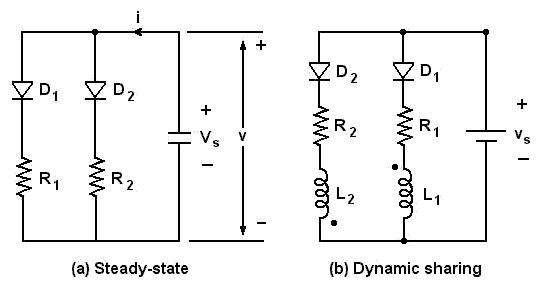Here’s the next article of the tutorial on Semiconductor Power switching devices. You can also write an article and send it to us by mail.
Diodes are connected inside the circuit in two configurations. These configurations are:
- Series configuration
- Parallel configuration
Both of the connection patterns are widely used and will be discussed in this article in detail along with diagrams.
Series Configuration
Series connection means a side by side connection. When two components are connected in series, they have one common junction. The variation of voltage and current in a series connection is as follows:
- Potential difference across every component is different.
- The current across every component connected in series remains the same.
The same properties also hold true for diodes when they are connected in a series configuration.
Diode Characteristics in Series Configuration
When connected in series, we observe the following properties to hold true among the diodes:
- Resultant diode’s forward voltage increases.
- Reverse blocking capabilities of diodes are increased in series connection.
Consider two diodes connected in series. The thing to be kept in mind over here is that all the diodes connected in series won’t have the same characteristics as shown in the graph below.
V-I characteristics show that the diodes have different blocking voltages. In forward biased state, the voltage drop and the forward current would be same on the diodes. While in the reverse biased the blocking voltage is different as the diodes have to carry the same leakage current.
This problem can be solved by connected resistances across every diode. Voltage would be shared equally; hence the leakage current would differ.
Total leakage current would now be:
Our requirement is:
We know,
So we get,
Area of Application
A single diode cannot meet higher voltage requirements, unless it is connected in series. So the major areas of application are:
- HVDC (High voltage direct current) transmission lines.
- Commercial areas where regulated voltage supply is needed.
Parallel configuration
Parallel connection means the components are connected across each other, having two common points. Current differs across each component while voltage drop is same. When diodes are connected in parallel, this same trend is observed.
Diode Characteristics in Parallel Configuration
- Current carrying capacity increases.
- No conduction in resultant diode in both sides.
Consider two diodes connected in parallel configuration. Current would be shared among the two diodes. To make this sharing equal, inductors (with same inductances) are connected. When current at D1 increases, the voltage drop across L1 increases, generating an opposite polarity value at L2.
Inductors are used for dynamic conditions. Inductors are usually bulky and expensive and generate spikes which can cause problems.
Diodes of same type having same voltage drops can be used for steady state conditions. In this case, the parallel diodes would have the same reverse blocking voltages. Some precautions are to be kept in mind while using the diodes with same forward voltage drops, which are:
- The diodes should have same heat sinks.
- They should be cooled equally when necessary.
Negligence would change the temperature of the diodes unequally. This will in turn cause the forward characteristics to differ which can create problems.
Areas of Application
- High power applications.
- Several diodes connected in parallel can match the desired current rating.
Finally, which configuration is to be used? Well, this depends on the voltage and current ratings of the application, as I have discussed earlier. Both the configurations can fulfill our requirements which a single diode cannot.
Thanks for reading me!
Nasir.




It’s well explained and easy to understand for beginners. Thank you.
thank u for help me ,u help us to find out where we deafed in our mind set
what will happen ,if I connect two different diodes (Si,Ge) in parallel with 1 volt dc power supply
Cant tell girll…
Thank you very much for sharing amazing knowledge on diode connections. In case of parallel connected diodes can we simply apply the Current divider rule for finding current?
How do you determine the correct size resistor to use in a steady state and dynamic sharing parallel circuits.